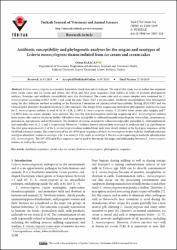| dc.contributor.author | Babacan, Orkun | |
| dc.date.accessioned | 2021-04-14T07:31:34Z | |
| dc.date.available | 2021-04-14T07:31:34Z | |
| dc.date.issued | 2020 | en_US |
| dc.identifier.issn | 1300-0128 | |
| dc.identifier.uri | https://doi.org/10.3906/vet-2003-116 | |
| dc.identifier.uri | https://hdl.handle.net/20.500.12462/11454 | |
| dc.description.abstract | Listeria monocytogenes is a zoonotic bacterium which also infects humans. The aim of this study was to isolate this organism from cream cakes and ice cream and obtain 16S rRNA and hlyA gene sequences from isolates in order to perform phylogenetic analyses. Serotypes and antibiotic susceptibility were also determined. The cream cake and ice cream samples were examined for L. monocytogenes according to ISO 11290-1 and using the mini Vidas LMO 2 kit procedure. Antibiotic susceptibilities were investigated using the disc diffusion method according to the European Committee on Antimicrobial Susceptibility Testing (EUCAST) and the Clinical and Laboratory Standards Institute (CLSI) standards. The Sanger DNA sequencing method for phylogenetic analysis was used for L. monocytogenes isolates. A total of 16 (n = 128, 12.50%) L. monocytogenes strains, 9 (12.16%) from cream cake samples and 7 (12.96%) from ice cream samples, were isolated. This was the first investigation involving sequencing of L. monocytogenes isolated from cream cakes and ice creams in Turkey. All isolates were susceptible to sulfamethoxazole/trimethoprim, tetracycline, streptomycin, gentamicin, meropenem, and erythromycin. The numbers of isolates resistant to sulbactam/ampicillin, penicillin G, chloramphenicol, and ampicillin were 16, 2, 1, and 1, respectively. Moreover, 3 isolates showed intermediate resistance to amikacin and 2 to ciprofloxacin. The hlyA gene sequences of 11 of the L. monocytogenesisolates isolated from milk were closely related to the hlyA gene sequences of the GenBank reference strains. The comparison of the 16s rRNA gene sequences of the L. monocytogenes strains with the GenBank reference serotypes identified 1 isolate as serotype 1/2c, 1 as serotype 1/2a, and 1 as serotype 4. Nucleic acid sequencing is useful for identification of L. monocytogenes. The 16S rRNAand hlyA sequences can be used to determine the origin and relationship between L. monocytogenes isolates, as well as the serotype. | en_US |
| dc.language.iso | eng | en_US |
| dc.publisher | Scientific Technical Research Council Turkey-Tubitak | en_US |
| dc.relation.isversionof | 10.3906/vet-2003-116 | en_US |
| dc.rights | info:eu-repo/semantics/openAccess | en_US |
| dc.rights | Attribution 3.0 United States | * |
| dc.rights.uri | http://creativecommons.org/licenses/by/3.0/us/ | * |
| dc.subject | Antibiotic Resistance | en_US |
| dc.subject | Cream Cake | en_US |
| dc.subject | Ice Cream | en_US |
| dc.subject | Listeria Monocytogenes | en_US |
| dc.subject | Phylogenetic | en_US |
| dc.subject | Sequence | en_US |
| dc.title | Antibiotic susceptibility and phylogenetic analyses for the origins and serotypes of Listeria monocytogenes strains isolated from ice cream and cream cakes | en_US |
| dc.type | article | en_US |
| dc.relation.journal | Turkish Journal of Veterinary and Animal Sciences | en_US |
| dc.contributor.department | Kepsut Meslek Yüksekokulu | en_US |
| dc.contributor.authorID | 0000-0003-0258-1825 | en_US |
| dc.identifier.volume | 44 | en_US |
| dc.identifier.issue | 5 | en_US |
| dc.identifier.startpage | 1100 | en_US |
| dc.identifier.endpage | 1109 | en_US |
| dc.relation.publicationcategory | Makale - Uluslararası Hakemli Dergi - Kurum Öğretim Elemanı | en_US |




















